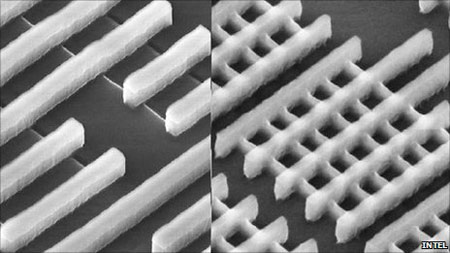Intel Reinvents Transistors Using New 3-D Structure – Will Tri-Gate Save Moore’s Law?
Intel Corporation today announced a significant breakthrough in the evolution of the transistor, the microscopic building block of modern electronics. For the first time since the invention of silicon transistors over 50 years ago, transistors using a three-dimensional structure will be put into high-volume manufacturing. Intel will introduce a revolutionary 3-D transistor design called Tri-Gate, first disclosed by Intel in 2002, into high-volume manufacturing at the 22-nanometer (nm) node in an Intel chip codenamed “Ivy Bridge.” A nanometer is one-billionth of a meter. Sustaining the progress of Moore’s Law becomes even more complex with the 22nm generation. Anticipating this, Intel research scientists in 2002 invented what they called a Tri-Gate transistor, named for the three sides of the gate. Today’s announcement follows further years of development in Intel’s highly coordinated research-development-manufacturing pipeline, and marks the implementation of this work for high-volume manufacturing. The 3-D Tri-Gate transistors are a reinvention of the transistor.

The image above shows traditional planar chip design (left) and Intel’s new Tri-Gate technology (right). Here is a great video that shows the upcoming 22nm process and what Intel did to solve the technology issues to get here.
The 22nm 3-D Tri-Gate transistors provide up to 37 percent performance increase at low voltage versus Intel’s 32nm planar transistors. This incredible gain means that they are ideal for use in small handheld devices, which operate using less energy to “switch” back and forth. Alternatively, the new transistors consume less than half the power when at the same performance as 2-D planar transistors on 32nm chips. “The performance gains and power savings of Intel’s unique 3-D Tri-Gate transistors are like nothing we’ve seen before,” said Mark Bohr, Intel Senior Fellow. “This milestone is going further than simply keeping up with Moore’s Law. The low-voltage and low-power benefits far exceed what we typically see from one process generation to the next. It will give product designers the flexibility to make current devices smarter and wholly new ones possible. We believe this breakthrough will extend Intel’s lead even further over the rest of the semiconductor industry.”

Comments are closed.